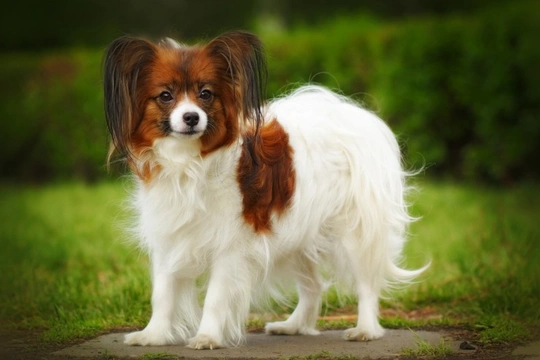
Pap-PRA1 (progressive retinal atrophy) testing for Papillon and Phalene dogs
Pap-PRA1 is a form of progressive retinal atrophy that has been identified as present in the Papillon dog breed, and the Phalene variant of the Papillon as well, but no other breed.
Progressive retinal atrophy is a hereditary health condition that can be found in the populations of many different pedigree dog breeds, and ultimately, the condition leads to a progressive and irreversible blindness that is not painful, but that can affect the dog’s quality of life due to their loss of vision.
While progressive retinal atrophy (PRA) always has the same end result in affected dogs, the mechanism of the condition’s action and the gene mutation that causes it varies across different breeds, which means that identifying the gene that causes it in any given breed and establishing a testing protocol for it varies from case to case.
In this article, we will look at the Pap-PRA1 variant of progressive retinal atrophy, which is unique to the Papillon dog breed, and the Phalene variant of the Papillon too. Read on to learn more about how the condition affects dogs, how the heredity of the condition works, and how to get your dog tested.
More about Pap-PRA1 progressive retinal atrophy
Progressive retinal atrophy affects the cells at the back of the retina, which are responsible for passing light and colour messages to the brain. Over time, these cells degenerate and die off and cannot be regenerated, even though affected dogs will be born with normal vision and may not show any symptoms of the condition until they are several years old.
As mentioned above, whilst all forms of progressive retinal atrophy lead to a progressive and irreversible blindness, different gene mutations can cause the condition, and so, they need to be tested for separately.
The form of progressive retinal atrophy that affects the Papillon dog breed is called the Pap-PRA1 mutation.
What sort of dogs can be affected by the condition?
The Pap-PRA1 gene mutation that causes progressive retinal atrophy is unique to the Papillon dog breed, and the Phalene variant too.
The Phalene is a sub-type of the Papillon breed, with the only distinction between the two being that the Papillon’s distinctive ears are erect, while the Phalene’s ears are drooped. Papillon and Phalene mean “butterfly” and “moth” respectively in the French language, and they are so named due to the long feathery hairs in the ears of the dog, which are said to look like the wings of butterflies and moths.
Dogs from the Papillon breed that are crossed with another unrelated breed can still pass the gene mutation that causes Pap-PRA1 to their offspring, but the inheritance of the gene fault from one side of the breed line is not enough to cause the affected form of the condition on its own.
However, such dogs can still become carriers for the condition, which means that if they are back-crossed to another pedigree Papillon, the condition may present in their subsequent litter.
How does the heredity of the condition work?
Pap-PRA1 progressive retinal atrophy is inherited by means of autosomal recessive heredity, which means that the status of both parent dogs combined is what dictates the status of their litter.
Dogs are assigned with a status for the condition after testing, being either clear, carrier or affected respectively. Knowing the status of the two parent dogs allows you to determine the status that their puppies will be.
- Two clear dogs will have clear puppies.
- Two affected dogs will have affected puppies.
- Two carriers will have a mixture of 50% carriers, 25% clear and 25% affected.
- A clear dog and a carrier will have a mixture of 50% clear and 50% carriers.
- A clear dog and an affected dog will have a litter of carriers.
- A carrier and an affected dog will have a mixture of 50% carriers and 50% affected.
How to get your dog tested
Testing for Pap-PRA1 falls under The Kennel Club’s official DNA testing scheme for the Papillon, which records incidences of the condition across the breed population in the UK as a whole, and allows Papillon owners that may be considering breeding from their dogs to find out the status of their own dog, and that of the dog’s potential mating match.
This helps to ensure that only dogs that will not produce affected puppies are used for breeding, and over time, the ultimate goal is to breed the mutation out of the gene pool of the breed altogether.
In order to get your dog tested, you will need to ask your vet to take a DNA sample from your dog in the form of a buccal swab (sample of the skin cells from the inside of the dog’s cheek) or a vial of blood.
This is then sent off to one of The Kennel Club’s approved laboratories for testing, who will then return your dog’s status and send a copy of the result to The Kennel Club too.



